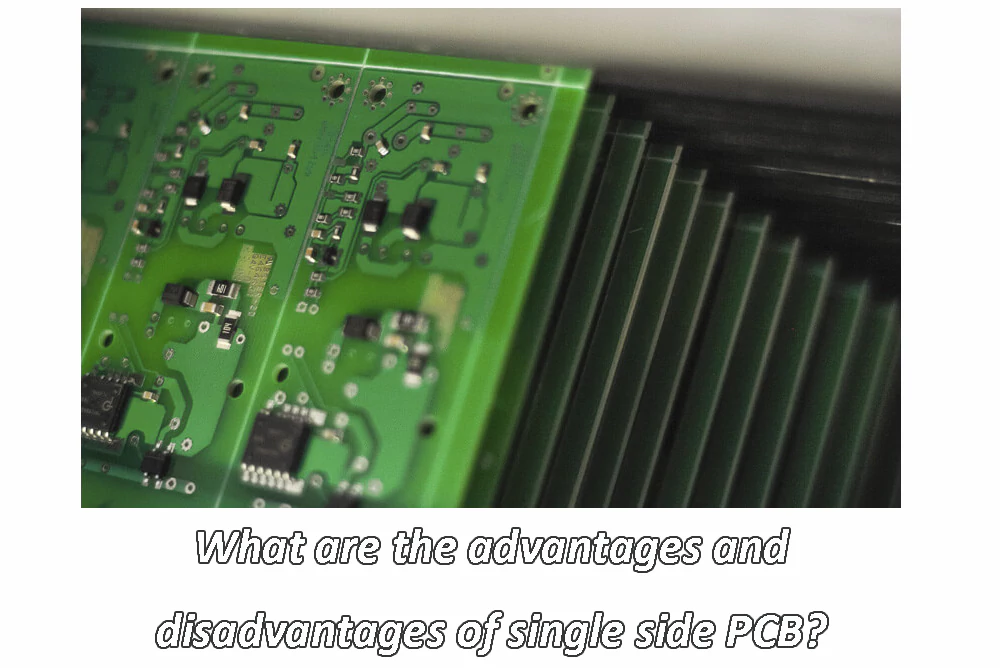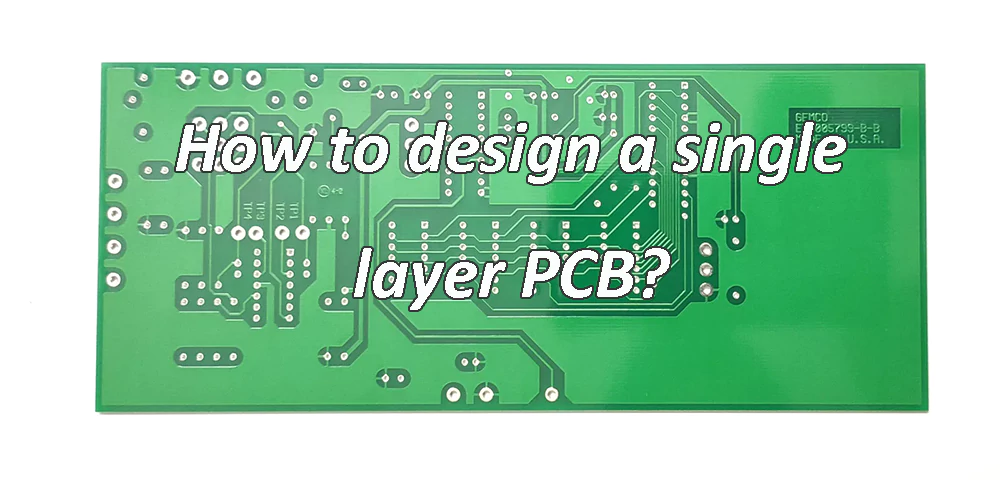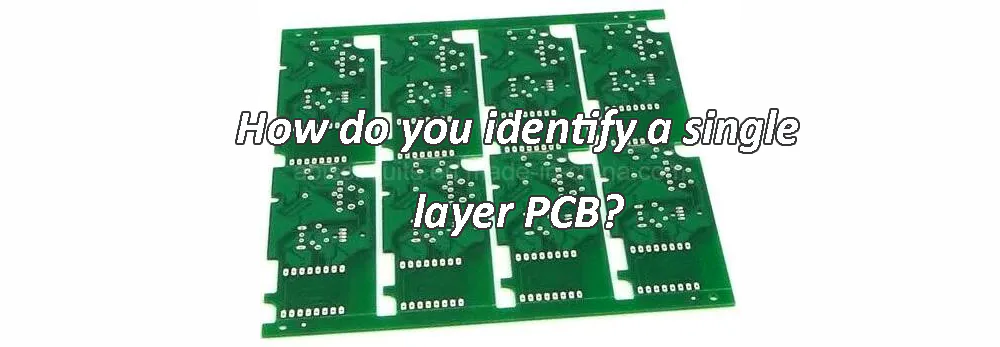Printed Circuit Boards (PCBs) serve as the backbone of electronic devices, facilitating the seamless flow of electrical signals between components. Among the various types of PCBs, the single-sided PCB stands out for its simplicity, cost-effectiveness, and widespread applicability. In this article, we will delve into the intricacies of single-sided PCB, exploring their advantages, applications, and the key role they play in modern electronics.
What is single sided PCB?
A single-sided PCB is a type of circuit board that has conductive traces, components, and pads on only one side of the board. The other side is typically used for soldering and may have a protective solder mask to prevent unintended electrical connections. Single-sided PCB is commonly used for simpler electronic devices and circuits where the complexity of the design doesn’t require components and traces on both sides of the board.
What are the advantages and disadvantages of single side PCB?

► Advantages of Single-Sided PCB:
-Cost-Effective: Single-sided PCBs are generally more cost-effective to produce compared to double-sided or multilayer PCBs. The manufacturing process is simpler, which leads to lower production costs.
-Ease of Design and Manufacturing: Single-sided PCBs are easier to design and manufacture, making them suitable for simpler electronic devices and projects with less complex circuitry.
-Easier to Troubleshoot and Repair: Since all the components and traces are on one side of the board, troubleshooting and repairing single-sided PCB are generally easier. It is more straightforward to identify and access components.
-Suitable for Low-Density Circuits: Single-sided PCBs are sufficient for circuits with lower component density and simpler routing requirements. They are often used in basic electronics projects and applications.
► Disadvantages of Single-Sided PCB:
-Limited Complexity: Single-sided PCB has limitations in terms of complexity. They may not be suitable for circuits with a high component density or intricate routing requirements.
-Space Constraints: The single layer available for components and traces may result in larger board sizes, which can be a constraint in space-sensitive applications.
-Reduced Signal Integrity: In complex circuits, the lack of a dedicated ground or power plane can lead to reduced signal integrity. This can result in increased susceptibility to electromagnetic interference (EMI) and signal crosstalk.
-Not Suitable for Advanced Circuits: For advanced electronic devices with sophisticated features, such as high-frequency applications or complex digital systems, single-sided PCB may not provide the required capabilities.
What are single sided PCBs used for?
Single-sided PCB is commonly used in a variety of applications, particularly where simplicity, cost-effectiveness, and ease of manufacturing are essential. Some common uses of single-sided PCB include:
● Consumer Electronics: Single-sided PCB is often found in simple consumer electronic devices such as calculators, TV remote controls, electronic toys, and basic household gadgets.
● LED Lighting: Single-sided PCB is suitable for basic LED lighting applications, such as LED displays, decorative lighting, and simple lighting control circuits.
● Power Supplies: Simple power supply circuits with fewer components and basic functionality can be implemented on single-sided PCB.
● Automotive Electronics: Some automotive applications, especially those with straightforward electronic functions such as lighting control, may use single-sided PCBs.
● Educational Projects: Single-sided PCB is commonly used in educational projects for teaching basic electronics and circuit design. They provide a cost-effective and manageable platform for learning.
● Prototyping: In the early stages of product development, when rapid prototyping is crucial, engineers may use single-sided PCB for initial testing and proof-of-concept designs.
● DIY Electronics: Hobbyists and DIY enthusiasts often use single-sided PCB for various projects due to their simplicity and ease of assembly.
● Low-Cost Applications: In applications where minimizing production costs is a priority and the circuit complexity is low, single-sided PCB can be a cost-effective solution.
How to design a single layer PCB?

Designing a single-layer PCB involves creating a layout for the circuit on a single side of the board. Here are the general steps to design a single-layer PCB:
Schematic Design:
Start by creating a schematic diagram of your circuit using a schematic capture tool. This diagram represents the connections between components. Ensure that the schematic is clear and logically organized.
Component Placement:
Once the schematic is complete, move to the PCB layout stage. Begin by placing the components on the PCB layout software. Consider the physical size of components, their orientation, and their interconnections. Try to arrange components in a way that minimizes the length of traces.
Routing:
Connect the components using copper traces. Since it’s a single-layer PCB, all traces will be on one side. Plan the routing carefully to avoid crossing traces and ensure a neat layout. Use vias only when necessary, as they can complicate the design and increase production costs.
Ground Plane:
If possible, designate a solid ground plane on the PCB. A ground plane helps improve the overall performance of the circuit by providing a low-impedance return path for currents. In a single-layer PCB, you might need to be creative in designing the ground plane, such as creating “islands” for ground connections.
Keep Components Close:
Keep components that need to be electrically connected close to each other. This minimizes trace lengths and reduces the risk of signal integrity issues.
Labeling and Documentation:
Add labels to your components and connectors for clarity. Provide necessary documentation, such as a reference designator for each component and any additional notes for assembly.
Silkscreen and Reference Designators:
Add a silkscreen layer to mark the components on the PCB. Reference designators (e.g., R1, C2) help identify each component and match them with the schematic.
Verify Design:
Use design rule checking (DRC) tools to ensure that your design meets the fabrication and assembly requirements. Check for spacing, clearances, and other design rules set by your PCB manufacturer.
Export Gerber Files:
Once the design is verified, export Gerber files from your PCB design software. Gerber files contain the information needed for PCB fabrication, including copper layers, solder mask, and silkscreen.
Fabrication:
Send the Gerber files to a PCB manufacturer for fabrication. Choose appropriate materials and specifications based on your project requirements.
Assembly:
Once you receive the fabricated PCB, you can proceed with the assembly by soldering the components onto the board.
How thick is single layer PCB?
The thickness of a single-layer PCB can vary depending on the specific requirements of the application and the materials used in its construction. However, for standard single-layer PCB, the typical thickness falls within a range of 0.6 to 1.6 millimeters (mm).
Here’s a breakdown of the common thickness options for single-layer PCB:
• 0.6 mm:
This thickness is commonly used in applications where space constraints are critical, and a thinner PCB is required. It is often found in smaller electronic devices and applications with limited available space.
• 1.0 mm:
A thickness of 1.0 mm is a standard option for many single-layer PCB. It provides a balance between space considerations and mechanical stability, making it suitable for a wide range of applications.
• 1.6 mm:
This thickness is frequently used when mechanical strength and durability are more critical than space constraints. It is a common choice for larger electronic devices and applications where the PCB may experience physical stress.
It’s important to note that these thickness values are general guidelines, and the actual thickness of a single-layer PCB can be customized based on the specific requirements of the project. Factors such as the type of substrate material (e.g., FR-4), the presence of a copper layer, and the overall design considerations influence the final thickness of the PCB.
How do you identify a single layer PCB?

Identifying a single-layer PCB can be done through visual inspection and by examining the physical characteristics of the board. Here are several key indicators to help identify a single-layer PCB:
1. Visual Inspection:
Components on One Side: In a single-layer PCB, all electronic components are typically mounted on one side of the board. This is because there is only one layer of conductive material, and components are soldered directly to the copper traces on that side.
2. Examine the Copper Traces:
Single Copper Layer: A single-layer PCB will have only one layer of copper. You can identify this by inspecting both sides of the board. If there is copper on only one side, it’s likely a single-layer PCB.
3. Thickness:
Thin Board: Single-layer PCB is generally thinner compared to multi-layer PCBs. If the PCB appears to be relatively thin (typically between 0.6 mm and 1.6 mm), it may be an indication of a single-layer board.
4. Visualize the Etching Pattern:
Simple Etching Pattern: In the manufacturing process of a single-layer PCB, a simple etching process is used to create the circuit pattern. The copper is etched away in areas that are not protected by the photoresist, leaving behind a straightforward circuit pattern.
5. Inspect for Vias:
No Vias: Unlike multi-layer PCBs, single-layer PCB does not have vias, which are conductive paths that connect different layers. If you don’t see any small holes or via structures on the board, it’s likely a single-layer PCB.
Conclusion
In the intricate world of electronics, single-sided PCB shines as versatile and cost-effective solutions. Their simplicity makes them ideal for various applications, from educational projects to consumer electronics. As technology continues to evolve, single-sided PCB will remain a valuable component in the toolkit of engineers and designers, offering an efficient and economical option for a wide range of electronic devices.
A single-sided PCB is a type of printed circuit board that has conductive traces, components, and pads on only one side of the board.
Cost-effective manufacturing, simplicity in design, ease of troubleshooting, and suitability for low-density circuits are some advantages of single-sided PCBs.
Single-sided PCBs are commonly used in consumer electronics, LED lighting, power supplies, educational projects, DIY electronics, and other applications where circuit complexity is low.










